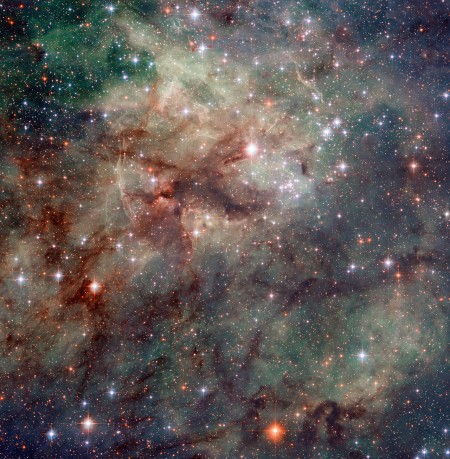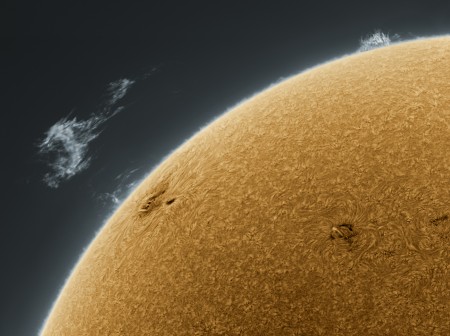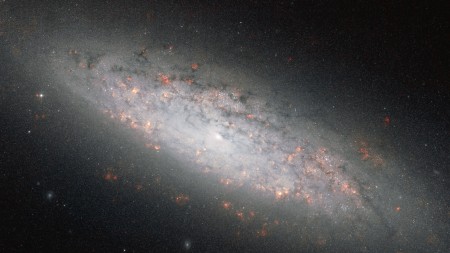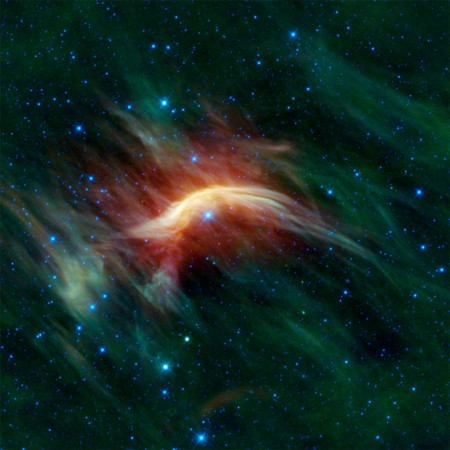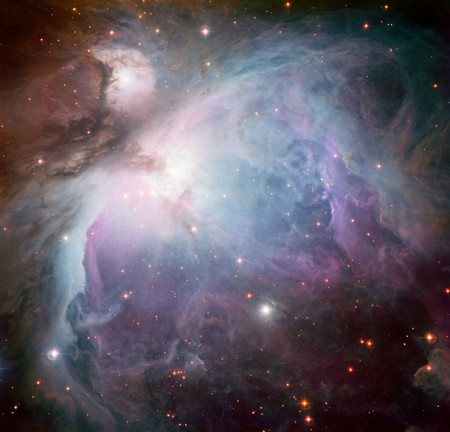#June2011
Two Videos Of An Enormous Explosion On The Sun Today. Existence Is Fun.
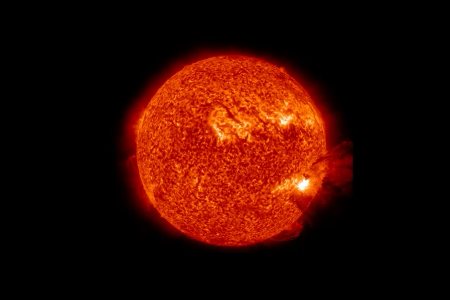
The Sun unleashed an enormous explosion today, and it’s one that has to get you staggered a bit with existential glee. Seeing the engine of our existence roar in its cosmic fury gets me a bit tingly. Jump inside for videos and Phil Plait breaking them down gloriously as usual.
Image Of The Tarantula Nebula Makes Me Shoot Web.
The Sun Turns A Detached Prominence Into Art.
Solar Eclipse From Space Shows Moon Reversing Direction. Wut?
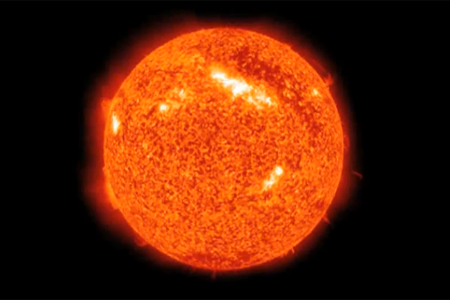
This video of the solar eclipse is rad for several reasons. For starters, you can see some pretty righteous magnetic activity on the Sun’s surface. The Sun is spittin’ like a mad dragon, fiery hotness! Also, it features an optical illusion wherein the Moon appears to enter the scene, and then somehow, reverse direction.
Hit the jump for the video.
‘Sidereal Motion’; Video That Shows The Motion Of The Stars
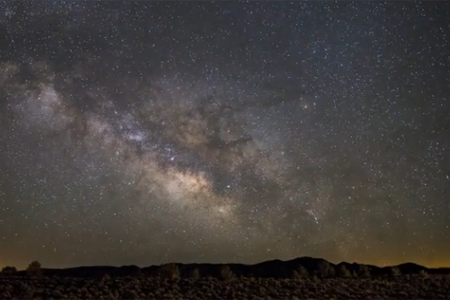
A new video by José Francisco Salgado featured over at Bad Astronomy displays the beauty of sidereal motion. That fancy term is used to describe the movement of the stars in the night sky. As Phil Plait explains, it is “the apparent rising and setting caused by the rotation of the Earth. You don’t notice it second-by-second as you watch the sky, but over minutes and hours the inevitability of our planet’s angular momentum makes itself known.”
Ah, our perceptions. I can’t help but wish I was capable of perceiving the Milky Way rise across a night sky without the aid of time-lapse. But for now, this’ll do.
Hit the jump for the video.
Phil Plait: There’s No Proof of A Giant Ninth Planet.
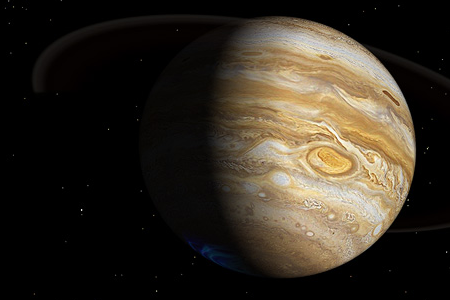
If you’re an astronomy geek like myself, Phil Plait is the man. His blog Bad Astronomy features daily space porn, and more than that, it features dissections and explanations of said space porn. When I mentioned the possible ninth planet Tyche a couple of days ago, I used the disclaimer, “I’m telling you to take everything I’m about to blather about as more than likely science fiction.”
According to Phil Plait, I’m probably right.
This Galaxy Surfs The Edge of Space! Tubular!
Enlarge. | Via.
NGC 6503 is a righteous galaxy. A loner, if you will. It sits far outside of the Local Cluster of galaxies, hanging out in a galactic void.
Phil Plait with the deets:
It’s on the edge of the great local void: a vast region of space where galaxies are few and far between. Galaxies tend to exist in clusters and superclusters. The Milky Way is part of the the Local Group, a small collection of a few dozen galaxies which itself sits on the outskirts of the Virgo Cluster, 60 million light years away. In the opposite (more or less) direction, toward the constellation of Draco, is the Local Void. Our galaxy is near the edge of this void, but NGC 6503 is actually further into it, 17 million light years away from us. Even then, it’s only on the void’s edge; estimates vary but the empty region extends for something like 30 — 200 million light years in that direction!
So you can picture it: on one side of us is a collection of hundreds of galaxies in the Virgo cluster, which itself is part of a much larger supercluster containing thousands of galaxies. On the other side of us is an empty region of roughly the same size. Somehow, when the Universe itself was young, the matter in this region must have all condensed toward Virgo, leaving the void nearby. We think the entire Universe is this way, with dense regions of matter surrounding bubble-like voids. If you could step back and look, the Universe might appear like a giant sponge!
Outstanding! It’s hard to conceive of giant voids of space that are inconceivably large. NGC 6503 dares to go where uh, only intergalactic eagles dare! But it must watch out as it peers into the abyss. You know what Nietzsche said about the void! Careful if you peer into it, because if you do, you may die alone in an insane asylum or whatever.
I’m paraphrasing.
Runaway Star Is Smashing Through The Cosmos!
Enlarge. | Via.
Behold Zeta Ophiuchi, a runaway star. Zeta is currently booking it through the cosmos, blasting through cosmic dust. What exactly is Zeta’s deal?
Bad Astronomy:
it’s a runaway star. It has a rather high speed compared to other stars, and we think we know why: it was once part of a binary system. It probably started off life with less mass, and it was orbiting a high mass star. The other star swelled up into a red supergiant, dumping vast amounts of material onto Zeta Oph. Then the star exploded as a supernova! When it did, it flung off Zeta Oph like a water droplet off a shaking dog. It wasn’t the explosion itself that pushed on the star; it was centripetal acceleration. The two stars were probably orbiting each other at high speed, and when the second star blew up, Zeta Oph kept that speed and flew off into space!
We see several such high-mass runaway stars, and we think that’s where they come from: they survived their partners going supernova.
But what the heck is all that stuff around it in the picture? WISE “sees” in infrared light, which is emitted by warm material like all that interstellar dust around Zeta Oph (which itself looks blue in this picture, but remember, it’s false color, even if Zeta Oph coincidentally really is blue). Most of that dust appears green in the image. But nearer the star that dust is considerably brighter for two reasons. One is that the material is being heated by the star itself as it passes through. But also there’s a fierce wind of material streaming off of Zeta Oph’s surface, and that’s ramming the dust, compressing it. Denser material, in this case, can glow more brightly than the thinner material around it.
Man! When my partner goes supernova, she generally drops a couple of karate chops on me and kicks me out of her apartment for the evening. Zeta got flung out of its friggin’ place in the universe.
High-Res Shot Of Orion Nebula. Daily Space Porn.
Enlarge. | Super-High Res [142 Mb]. | Via.
Behold!, the Orion Nebula. If you haven’t clicked for the larger version, go, do it! The definition is ridiculous, no? This picture is staggering. As usual, Phil Plait at Bad Astronomy breaks down exactly what we’re looking at:
The nebula is a vast cloud of gas, both atomic and molecular, and dust located about 1350 light years away. It’s one of the largest star forming factories in the Milky Way, and what you see here is well over 20 light years across.
For years I figured it was just a diffuse glowing thing in space, but it turns out to be more complicated than that. In reality, a lot of the nebula is actually a dark, dense molecular cloud – literally, composed of molecules like H2 (molecular hydrogen) and CO (carbon monoxide). This cloud is actually far, far larger than what you see in this image, perhaps 20 times the width! But it’s dark, so we don’t see it in visible light… and what we’re seeing in this picture is not really a free-floating gas cloud, but a cavity in the wall of the denser dark cloud.
Stars are being born inside that cloud. Some of them are very massive, hot, and bright. They blast out a fierce stellar wind, like the solar wind but far more powerful. They also emit a fierce flood of ultraviolet photons. Together, these two forces erode away at the material of the cloud, breaking apart the molecules into their constituent atoms, ionizing them, and causing them to glow. It so happens that some of these stars were born near the side of this cloud, so when they ate away the insides of the cloud it caused a blister in the side which burst open.
You can actually see that in this image! The bulk of the colorful nebula, from the upper left on down, is actually gas inside this cavity set aglow. The far wall is opaque and dark, so you don’t see it here. But you can get a sense of the bubble-like nature of the nebula.
Outstanding. There’s your existential nausea for the day.
Behold The Blood Red Whirlpool Galaxy [Of Hell.]
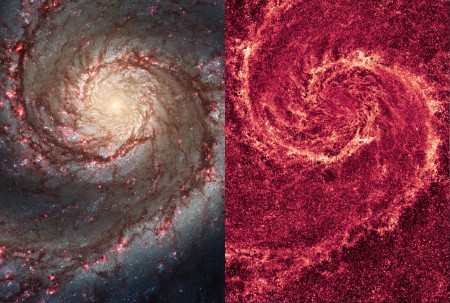
Behold the inner sanctum of Hell! You probably thought that the Devil lived in some dingy-ass cave, right? Shitty halls and screams? Naw, he lives here. Where is here? The Whirlpool Galaxy, but you can call it M51. We have one picture of it on the left, looking all safe and shit. On the right, however, we have its true form exposed. The sanctum of El Diablo.
The Hubble’s site explains the two different views:
The image at left, taken in visible light, highlights the attributes of a typical spiral galaxy, including graceful, curving arms, pink star-forming regions, and brilliant blue strands of star clusters. In the image at right, most of the starlight has been removed, revealing the Whirlpool’s skeletal dust structure, as seen in near-infrared light. This new image is the sharpest view of the dense dust in M51. The narrow lanes of dust revealed by Hubble reflect the galaxy’s moniker, the Whirlpool Galaxy, as if they were swirling toward the galaxy’s core.
Outstanding.
Hit the jump for a high-res version of the Devil’s Regions revealed.




